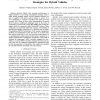Free Online Productivity Tools
i2Speak
i2Symbol
i2OCR
iTex2Img
iWeb2Print
iWeb2Shot
i2Type
iPdf2Split
iPdf2Merge
i2Bopomofo
i2Arabic
i2Style
i2Image
i2PDF
iLatex2Rtf
Sci2ools
84
Voted
CDC
2008
IEEE
2008
IEEE
Incorporating drivability metrics into optimal energy management strategies for Hybrid Vehicles
— Hybrid Vehicle fuel economy performance is highly sensitive to the energy management strategy used to select among multiple energy sources. Optimal solutions are easy to specify if the drive cycle is known a priori. It is very challenging to compute controllers that yield good fuel economy for a class of drive cycles representative of typical driver behavior. Additional challenges come in the form of constraints on powertrain activity, like shifting and starting the engine, which are commonly called “drivability” metrics. These constraints can adversely affect fuel economy. The benefits of including drivability restrictions in a Shortest Path Dynamic Programming (SPDP) formulation of the energy management problem are investigated for the first time. It is shown that this method yields up to 10% fuel economy improvement on a representative parallel electric hybrid when compared to a simpler instantaneous optimization formulation. This result is obtained by comparing a SPDP con...
| Added | 29 May 2010 |
| Updated | 29 May 2010 |
| Type | Conference |
| Year | 2008 |
| Where | CDC |
| Authors | Daniel F. Opila, Deepak Aswani, Ryan McGee, Jeffrey A. Cook, Jessy W. Grizzle |
Comments (0)

